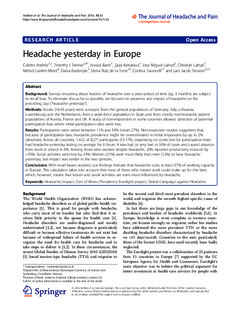| dc.contributor.author | Andree, Colette | |
| dc.contributor.author | Steiner, Timothy J. | |
| dc.contributor.author | Barre, Jessica | |
| dc.contributor.author | Katsarava, Zaza | |
| dc.contributor.author | Lainez, Jose Miguel | |
| dc.contributor.author | Lampl, Christian | |
| dc.contributor.author | Lanteri-Minet, Michel | |
| dc.contributor.author | Rastenyte, Daiva | |
| dc.contributor.author | Ruiz de la Torre, Elena | |
| dc.contributor.author | Tassorelli, Cristina | |
| dc.contributor.author | Stovner, Lars Jacob | |
| dc.date.accessioned | 2019-11-07T06:53:31Z | |
| dc.date.available | 2019-11-07T06:53:31Z | |
| dc.date.created | 2014-11-19T23:06:42Z | |
| dc.date.issued | 2014 | |
| dc.identifier.citation | The Journal of Headache and Pain. 2014, 15 (33) | nb_NO |
| dc.identifier.issn | 1129-2369 | |
| dc.identifier.uri | http://hdl.handle.net/11250/2627054 | |
| dc.description.abstract | Background
Surveys enquiring about burden of headache over a prior period of time (eg, 3 months) are subject to recall bias. To eliminate this as far as possible, we focused on presence and impact of headache on the preceding day (“headache yesterday”).
Methods
Adults (18-65 years) were surveyed from the general populations of Germany, Italy, Lithuania, Luxembourg and the Netherlands, from a work-force population in Spain and from mostly non-headache patient populations of Austria, France and UK. A study of non-responders in some countries allowed detection of potential participation bias where initial participation rates were low.
Results
Participation rates varied between 11% and 59% (mean 27%). Non-responder studies suggested that, because of participation bias, headache prevalence might be overestimated in initial responders by up to 2% (absolute). Across all countries, 1,422 of 8,271 participants (15-17%, depending on correction for participation bias) had headache yesterday lasting on average for 6 hours. It was bad or very bad in 56% of cases and caused absence from work or school in 6%. Among those who worked despite headache, 20% reported productivity reduced by >50%. Social activities were lost by 24%. Women (21%) were more likely than men (12%) to have headache yesterday, but impact was similar in the two genders.
Conclusions
With recall biases avoided, our findings indicate that headache costs at least 0.7% of working capacity in Europe. This calculation takes into account that most of those who missed work could make up for this later, which, however, means that leisure and social activities are even more influenced by headache. | nb_NO |
| dc.language.iso | eng | nb_NO |
| dc.publisher | BioMed Central | nb_NO |
| dc.relation.uri | http://www.ncbi.nlm.nih.gov/pmc/articles/PMC4045996/pdf/1129-2377-15-33.pdf | |
| dc.rights | Navngivelse 4.0 Internasjonal | * |
| dc.rights.uri | http://creativecommons.org/licenses/by/4.0/deed.no | * |
| dc.title | Headache yesterday in Europe | nb_NO |
| dc.type | Journal article | nb_NO |
| dc.type | Peer reviewed | nb_NO |
| dc.description.version | publishedVersion | nb_NO |
| dc.source.pagenumber | 8 | nb_NO |
| dc.source.volume | 15 | nb_NO |
| dc.source.journal | The Journal of Headache and Pain | nb_NO |
| dc.source.issue | 33 | nb_NO |
| dc.identifier.doi | 10.1186/1129-2377-15-33 | |
| dc.identifier.cristin | 1174942 | |
| dc.description.localcode | © 2014 Andrée et al.; licensee Springer. This is an Open Access article distributed under the terms of the Creative Commons Attribution License (http://creativecommons.org/licenses/by/2.0), which permits unrestricted use, distribution, and reproduction in any medium, provided the original work is properly credited. | nb_NO |
| cristin.unitcode | 194,65,30,0 | |
| cristin.unitcode | 1920,16,0,0 | |
| cristin.unitname | Institutt for nevromedisin og bevegelsesvitenskap | |
| cristin.unitname | Nevroklinikken | |
| cristin.ispublished | true | |
| cristin.fulltext | original | |
| cristin.qualitycode | 1 | |

